Эфиопия, родина арабики и одна из самых известных стран-производителей кофе в мире, по прогнозам, сохранит стабильный объём производства — 4,5 миллиона мешков по 60 кг в маркетинговом году 2024/25. Об этом говорится в последнем отчёте Службы сельскохозяйственных иностранных рынков Министерства сельского хозяйства США (USDA FAS). Этот стабильный уровень производства подчёркивает устойчивость кофейного сектора Эфиопии на фоне продолжительной засухи и меняющихся климатических условий.
Кофе остаётся основой сельской экономики страны, обеспечивая средствами к существованию более чем 15 миллионам человек, в основном мелким фермерам. Несмотря на растущие производственные трудности, включая нерегулярные осадки и ограниченную ирригационную инфраструктуру, Эфиопия продемонстрировала удивительную способность адаптироваться и сохранять производство на почти рекордном уровне. Прогноз на 2024/25 год совпадает с показателями предыдущего сезона, подтверждая статус Эфиопии как пятого крупнейшего производителя арабики в мире.
Хотя в прошлом сезоне уровень осадков оказался ниже среднего, особенно в южных регионах выращивания кофе, таких как Сидама и Иргачеф, производство в значительной степени удалось сохранить благодаря устойчивости традиционных агролесных систем. Использование теневых деревьев, минимальное применение химикатов и межкультурные посадки не только поддерживают экологическое равновесие, но и способствуют сохранению урожайности даже в стрессовых климатических условиях.
Кроме того, хотя высокие мировые цены на кофе в начале 2024 года изначально стимулировали расширение производства, фермеров в дальнейшем сдерживали высокие затраты на ресурсы и нестабильные погодные условия. Тем не менее, растёт интерес к засухоустойчивым сортам кофе, а государственные программы аграрного консультирования помогают производителям справляться с экологическими вызовами.
Экспорт кофе из Эфиопии в 2024/25 году, по прогнозам, достигнет 4,0 миллиона мешков — немного больше, чем 3,98 миллиона в предыдущем сезоне. Эфиопия остаётся одной из немногих ведущих стран, экспортирующих как мытый (влажной обработки), так и натуральный (сухой обработки) кофе в больших объёмах. В стоимостном выражении кофе продолжает оставаться главным источником поступлений иностранной валюты в страну. Основные рынки сбыта — Германия, Саудовская Аравия, США, Япония и Южная Корея.
Эфиопский кофе ценится во всём мире за свои уникальные вкусовые профили — от цветочных и цитрусовых до фруктовых и винных оттенков, особенно из таких регионов, как Гуджи, Лиму и Харрар. Эти отличительные характеристики позволяют экспортёрам из Эфиопии выходить как на премиальные рынки specialty кофе, так и на массовые сегменты.
Несмотря на нестабильные международные цены и колебания валютного курса, Эфиопское агентство по кофе и чаю (ECTA) сотрудничает с местными кооперативами с целью улучшения прослеживаемости, контроля качества и доступа к рынкам для мелких производителей. Страна также активно участвует в международных кофейных выставках и получила положительные отклики на мероприятиях, таких как Specialty Coffee Expo в Чикаго.
Хотя экспорт продолжает доминировать в кофейной отрасли, внутреннее потребление также стабильно растёт и, по оценкам, достигнет 534 000 мешков в 2024/25 году. Питьё кофе глубоко укоренено в эфиопской культуре, а традиционная кофейная церемония остаётся важным ритуалом как в городах, так и в деревнях.
Городской спрос на обжаренный и молотый кофе также увеличивается благодаря развитию современной розничной торговли, местных обжарочных производств и сетей кофеен в Аддис-Абебе и других крупных городах. Этот внутренний рынок помогает фермерам частично защититься от внешнеэкономических шоков.
Смотря в будущее, кофейный сектор Эфиопии сталкивается с рядом серьёзных вызовов. Среди них — продолжающееся обесценивание эфиопского быра, высокие транспортные издержки и ограниченный доступ к финансам для фермеров и экспортёров.
Кроме того, климатическая нестабильность остаётся долгосрочной угрозой. Хотя традиционные производственные системы помогли смягчить последствия недавней засухи, стране необходимо увеличить инвестиции в научные исследования, аграрные консультации и инфраструктуру, чтобы быть готовой к будущим климатическим потрясениям.
Всё больше опасений вызывает также фрагментация регулирования и медленные темпы реализации реформ в кофейном секторе. Некоторые частные экспортёры выражают недовольство бюрократическими барьерами и недостаточной прозрачностью Эфиопской товарной биржи (ECX), хотя правительство постепенно разрешает прямой экспорт specialty кофе в рамках новой модели вертикальной интеграции.
Несмотря на все трудности, кофейный сектор Эфиопии стоит на прочной основе традиций, биологического разнообразия и качества. Способность страны сохранять стабильное производство и экспорт в условиях экологического и экономического давления свидетельствует о глубокой устойчивости, которой могут похвастаться немногие страны-производители.
По мере роста мирового спроса на высококачественный и отслеживаемый кофе, Эфиопия имеет все шансы воспользоваться своим уникальным наследием — при условии, что продолжит инвестировать в климатическую адаптацию, прозрачность цепочки поставок и рыночные реформы.
